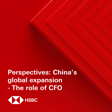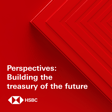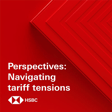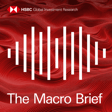Become a Creator today!Start creating today - Share your story with the world!
Start for free
00:00:00
00:00:01

The Macro Brief – Rates, shutdowns and bubbles
In this US special, Ryan Wang, US Economist, and Alastair Pinder, Head EM and Global Equity Strategist, discuss the Fed’s next move, the impact of the government shutdown and fears of an AI bubble.
Disclaimer: https://www.research.hsbc.com/R/101/xfXR9xh
Stay connected and access free to view reports and videos from HSBC Global Investment Research follow us on LinkedIn https://www.linkedin.com/feed/hashtag/hsbcresearch/ or click here: https://www.gbm.hsbc.com/insights/global-research.
Transcript
Introduction & Subscription Encouragement
00:00:01
Speaker
Welcome to HSBC Global Viewpoint, the podcast series that brings together business leaders and industry experts to explore the latest global insights, trends, and opportunities.
00:00:13
Speaker
Make sure you're subscribed to stay up to date with new episodes. Thanks for listening, and now onto today's show.
00:00:29
Speaker
Hello,
Introduction to The Macro Brief Podcast
00:00:30
Speaker
I'm Aline Van Dyne in New York and welcome to The Macro Brief, the podcast that looks at the issues driving financial markets across the globe. Fresh off the back of a cut in US interest rates this week, we're getting into the outlook for the US.
00:00:45
Speaker
What's the Federal Reserve going to do next? What's the impact of the government shutdown and tariffs? How are immigration shifts affecting labor supply? And we're also discussing fears of an AI bubble.
00:00:57
Speaker
So I'm joined here in our New York studio by Ryan Wang, our chief U.S. economist, and Alistair Pinder, head global equity strategist. Welcome back to the podcast.
00:01:09
Speaker
Thanks
Potential Federal Reserve Rate Cuts and Economic Tensions
00:01:10
Speaker
for having us. Thank you, Elaine. Thanks for having us. So, Ryan, let's kick off with one of the biggest questions in the markets. Will the Federal Reserve cut again in December? Well, that absolutely is a salient question. The Fed has now delivered two consecutive 25 base point rate cuts in September and October.
00:01:27
Speaker
But Fed Chair Jerome Powell, in the press conference following the October meeting, expressed some doubts about whether or not a third consecutive rate cut would be coming in December. And the reason for that is relatively straightforward. There's still a tension between what's happening on the inflation side and what's happening to both economic activity and labor markets in the United States.
00:01:48
Speaker
That tension is creating some disagreements amongst f FOMC policymakers about the speed of future rate cuts, how to balance these risks. And our own view for some time has been that actually the Fed would deliver a December rate cut but then not cut policy rates any further in 2026 or 2027. And that in large part has been because inflation is still running much closer to 3% than the level that the f FOMC targets.
00:02:16
Speaker
So we do have a more hawkish view, essentially, than than what the market's pricing in. But let's just get back to some of this doubt about December and about the outlook. Is any of that related to the government shutdown and the lack of data that's available at the moment?
00:02:33
Speaker
I think that's definitely a complicating factor because going into this government shutdown, which started on October the 1st, it appeared that basically the job market was was slowing in terms of employment growth.
00:02:45
Speaker
um Another actually related puzzle is that GDP growth has arguably surprised to the upside this year. That's pretty unusual to see slowing employment growth but resilient GDP. ah against this backdrop of sticky inflation running relatively close to 3%.
00:03:00
Speaker
And then if you drill down into the labor market, there's also questions there because the softness in employment growth clearly reflects a combination of both reduced labor demand and reduced labor supply.
00:03:11
Speaker
And so how is the Fed to deal with all this? Well, it doesn't help at all. It only complicates the matter when traditional economic releases are being disrupted, such as on the jobs report. I think Chair Powell referred to it as driving in fog.
00:03:24
Speaker
That's right. And that's where there could be this extra element. And Chair Powell also talked about, you know, a growing chorus on the FOMC that perhaps the Fed should at least sort of skip a cycle. Again, that could be a reference to not delivering another rate cut in December.
00:03:42
Speaker
And it's a very relevant question. Even when the government shutdown ends, The economic data that we've missed will not be released all at once. It will have to be calculated. There will have to be a new schedule. So that very much raises the question of what economic information will FOMC policymakers even have at the December meeting?
00:03:59
Speaker
I mean, so the
Inflation Drivers and Policy Challenges
00:04:00
Speaker
data they do have at the moment, this inflation data, which has been, as you say, quite sticky. I mean, what's the underlying drivers of that at this point? And does and does tariffs have an impact here as well? Yeah, so this is very interesting. i think over the past three or four months, we've seen evidence that goods prices, some goods prices in particular, those that are very import intensive, have been rising a bit due to higher tariffs.
00:04:21
Speaker
That should continue to be the case over the year ahead. ah The question is magnitude. Goods are relatively the smaller portion of the consumer basket. So in a way, the bulk of the near 3% inflation, you could say, is still more related to services because services inflation is running higher than goods inflation.
00:04:40
Speaker
So it's a bit of a complicated picture right now. ah But when you add up the details, the fact is there's still a pretty big gap between what the Fed is targeting and and where the numbers lie.
00:04:51
Speaker
And Ryan, is our view on inflation and the stickiness of inflation, is that the key reason that we have a different perspective in terms of the rate cut ah cycle ahead?
00:05:02
Speaker
Yeah, I think that's one key reason we see inflation relatively close to 3%, the end of next year. But the other feature that we've been flagging is that the f FOMC is divided on what actually constitutes a neutral rate of policy. Actually, this came up in the October press conference. Chair Powell suggesting it could be somewhere between 3% and 4%. Well, the actual policy rate is now below 4%. So we're basically at the top range of what some on the FOMC might think of as neutral.
00:05:32
Speaker
And remind us why this neutral rate is important. It's important because in theory it's the rate that sort of balances out the economy. And and and the the issue is that it can only be observed indirectly.
00:05:46
Speaker
Is the policy rate putting downward pressure on the economy or is it boosting the economy? And this is where the disagreement lies. But in ah as a practical matter, the policymakers that think the neutral rate is higher are likely advocating for smaller and less rate cuts. And hence, this is why the decision is going to become more complicated in December and then next January and next March and beyond.
00:06:08
Speaker
So, Alistair, I want to bring in ah the feedback that you've had from investors. You've met with lots of investors around the globe in recent weeks. What's their perspective? What are they ah talking to you about?
Market Concerns: Federal Reserve Stance & AI Bubble
00:06:20
Speaker
I mean, when it comes to the Fed, I think this question about how dovish will the Fed be going into next year is is a hot topic. And i think for me, kind of marrying with with Ryan's view here, I think the biggest risk going into 2026 equities is that the Fed is more hawkish.
00:06:37
Speaker
ah The back end of the yield curve starts to steepen as as the market prices out prices out, all of these cuts, and equity valuations start to decline. And that to me is something which does concern me a lot.
00:06:48
Speaker
Our multi-asset team have this great thing, they call it the danger zone. This is the level of bond yields where ah it starts to you know really crunch on on valuations. We're quite far away from that. They think it's around 4.7%.
00:06:59
Speaker
But it's always in the back of my mind that if The Fed is more hawkish and it starts to you know really weigh on sentiment. Given how much the equity market has run, there is ah there's a lot of scope for disappointment at this point.
00:07:11
Speaker
So it is obviously a ah big talking point. Tell us, what was the main question that investors were talking about? Was this the main topic or was there another hot topic? The number one question was whether we are in an AI bubble.
00:07:24
Speaker
And so to a certain extent, i felt slightly reassured by that because if everyone's asking me whether in an AI bubble, that would indicate to me that maybe we're not quite yet at the top of the AI bubble.
00:07:35
Speaker
So I do think it's on everyone's mind. I don't think we're yet at the peak of ah the AI trade. But there has been a phenomenal amount of capex that has been announced by these magnificent seven stocks.
00:07:48
Speaker
I mean, this year alone, this is probably going to be in excess of $350 billion dollars of capex that is being spent. And they're asking, how do you monetize this? And presumably that spend is one of the reasons the US economy is perhaps coming in relatively stronger than than expected or accounts for some of the resilience Yeah, absolutely. If you think about it in a very straightforward fashion, the current boost of AI investments to GDP growth is just from that direct ah capital expenditure that businesses are are undertaking. And then the second piece of the puzzle, which may play out over years, is what those investments might do to productivity growth.
00:08:30
Speaker
So I don't think we've seen the full effects of that second part yet. And that's the bigger question. You know, what sort of productivity growth will be delivered? And can that justify the admittedly very sizable investments that are happening right now?
00:08:41
Speaker
I think this productivity question so interesting and so, you know, important. And As you say, Ryan, i think at the the macro level, you don't see a huge amount of productivity coming through.
00:08:54
Speaker
But if you go to the S&P 500 and you look at these large cap companies, you are seeing them actually implement AI and try and become more productive.
00:09:04
Speaker
Now, worryingly, maybe for all of us with jobs, the way they're becoming more productive is basically replacing ah humans with you know AI agents or or whatever else.
00:09:15
Speaker
But it's clear that it's having, you know incrementally, particularly for the large cap companies, some impact on their workforce. So let's just ah dwell on that for a minute.
00:09:25
Speaker
Ryan, is there any evidence yet that the AI investments are impacting the labor force? Well, I think we've definitely seen companies, both big and small, increasingly refer to this. And I do think it's something that has only happened this year, where where many companies, again, of different sizes are clearly saying that, okay, this could be an additional reason to be a little bit more cautious on hiring.
00:09:48
Speaker
Maybe there's a marrying of some uncertainty about the economic outlook and then saying, look, we can also try to find some labor-saving processes, perhaps using AI, and and that'll be part of the picture that is that is clearly unfolding right now.
Labor Supply Issues & Economic Growth Trends
00:10:02
Speaker
I would also connect this to kind of a broader kind of macro notion of what typically constitutes potential GDP growth or trend GDP growth basically can be an addition of labor supply plus productivity.
00:10:14
Speaker
And really, the U.S. is experiencing some, again, some puzzles right now because labor supply growth is being restrained by the effects of slower immigration. At the same time, that productivity growth may be being boosted by AI and other factors.
00:10:27
Speaker
And so, you know, traditionally, we might have thought of potential GDP growth as close to 2%. It may still be close to 2%, but the mix may have changed. What has the impact been of slower immigration?
00:10:39
Speaker
Well, I think we've seen it most clearly in the employment numbers, and I referred to this combination of slower labor demand and slower labor supply. And it's also changed what we should think of as a break-even employment rate.
00:10:52
Speaker
The Federal Reserve Bank of Dallas, for example, has done some estimates that it could be below 50,000 per month, and that is a lot lower than than than what we typically would have thought of as a trend employment number.
00:11:05
Speaker
This is this is the the numbers that you see in the monthly payrolls data? That's right. And it has particular relevance for FOMC policymakers because essentially it's defined as the rate of job creation needed to keep the unemployment rate stable.
00:11:21
Speaker
And actually, if you look at it, the unemployment rate has not risen that much over the past year, even as employment growth has slowed. So that's another sign that, you know, typically we would have thought 100,000 or more is ah is a normal level of employment growth. But now that number may be somewhere in the zero to 50,000 range. And if that number is lower, it means that if you have lower payrolls, it's not necessarily a sign of an economic slowdown.
00:11:46
Speaker
Well, it still implies slower economic growth, but it doesn't necessarily mean that the Federal Reserve is missing on its employment mandate if the unemployment rate stays relatively low.
00:11:58
Speaker
So if this this payrolls number, I think, and this is one of the key questions, I think everyone's super confused by this because it's kind of like, is it supply? Is it the demand? And if it's a mixture of two, would you say that there's any other sort of variables or indicators that we should be watching to see if there is a demand issue in the labor market at this point?
00:12:17
Speaker
Like is initial jobless claims, for example, the thing that we should be watching more than than payrolls at this point? Well, initial jobless claims is very relevant, and definitely I would still will you watch be watching those numbers.
00:12:28
Speaker
Somewhat interestingly, many states are still releasing those numbers even during the government shutdown. So because most states are releasing those numbers, they still can be added up. And those have remained relatively stable, suggesting that the U.S. economy continues to exhibit this kind of low hiring but also low firing behavior.
00:12:47
Speaker
Now, to answer your question more directly, I would just pin it down to the unemployment rate. Because the kind of break-even jobs growth is basically defined as whether the unemployment rate is rising or falling, we can look to that to resolve our questions.
00:13:03
Speaker
Separately, we can look at the non-farm payrolls number and compare that to uncertain estimates of break-even employment, perhaps in that 50,000 or less range. So we can look at both of these signals. It is very confusing.
00:13:14
Speaker
It's not possible to say in real time what population growth is really confusing. doing in the United States. That's the cause of of a lot of this uncertainty.
Fiscal Policies and Economic Resilience
00:13:23
Speaker
Is there anything else ah before we wrap up that you think we need to really flag as we're looking to the US outlook for next year? I mean, clearly there are a lot of puzzles.
00:13:34
Speaker
The overall backdrop is actually quite positive and resilient, but there's a lot of uncertainty about the outlook for policy rates. about how to interpret the employment data, what's happening with AI and productivity. So obviously these are all things that we're gonna be looking into ah for next year. And also the continued questions around the reduction in immigration, what does that mean for the economy?
00:14:03
Speaker
Anything else that you think ah our listeners should be thinking about for next year? I mean, from my side, again, thinking from an equity perspective, as you mentioned, there's so many uncertainties and yet the S&P 500 is almost at record highs and valuations are also extremely elevated.
00:14:20
Speaker
And so it's kind of climbing this wall of worry. and And for us, it's thinking about well, what can keep on driving equity markets higher? And I think one of the very interesting things that we're seeing in in the US right now is that um for the Magnificent Seven and tech, earnings growth is actually slowing down, but the rest of um the market's earnings growth is actually re-accelerating.
00:14:42
Speaker
And that that's a really important point. I think actually the Mag-7, again, put it into perspective, they count for like a third of the S&P 500. It's huge. And their earnings growth has basically lifted the earnings growth for the entire market. But for the rest of the US companies, they've essentially been in a mild earnings recession from 2022 to 2024.
00:15:01
Speaker
And now earnings growth is reaccelerating. And has that really become clear in the the latest Q3 results? I mean, definitely. I mean, in the q three earnings results, you know, there's some estimates basically say that around 87% of companies have beaten expectations. i mean, it's phenomenal.
00:15:20
Speaker
It's truly, it's it's it's really quite remarkable how amid all of these uncertainties, amid tariffs, et cetera, companies continue to deliver very strong earnings. So for me, it's this this resiliency and perhaps particularly going into next year, broadening of the equity market performance outside of just tech.
00:15:38
Speaker
Ryan? Well, I would add in that we also have to pay attention to the basically the fiscal flows in the United States. And going into 2026, there has been a reduction in some individual tax taxes and also some incentives for businesses on the tax side to to really promote investments.
00:15:57
Speaker
So that's one another factor that should be supportive of growth. On the other hand, there's also an offset that that in a way is coming through from higher tariffs because as the government is taking in increased tariff revenue, that basically absorbs cash flow from the private sector.
00:16:12
Speaker
And so that balance will be very interesting to watch next year as well. Well, look, thank you both so much. And we'll be back to see how all this plays out. Thanks for having us.
00:16:24
Speaker
Thanks so much.
00:16:29
Speaker
Before we go, a reminder to check out the latest edition of our sister podcast, Under the Banyan Tree, where hosts Fred Newman and Harold van der Linde put Asian markets and economics into context.
Podcast Promotion and App Features
00:16:42
Speaker
On this week's episode, ASEAN economist Aris Dakene is in our Hong Kong studio to explain why Southeast Asian economies could actually see rising market share across various sectors as a result of U.S. import tariffs.
00:16:57
Speaker
And don't forget that the HSBC Global Investment Research app is available to our clients. It features all of our latest reports, videos, and podcasts, and it can now read out our research to you with its listen functionality.
00:17:13
Speaker
Just head to Apple's App Store or Google Play to download it.
00:17:22
Speaker
Now, this 30th of October edition of The Macro Brief was produced and edited by Tom Barton. You can get in touch with us at askresearch at hsbc.com if you have any questions or comments.
00:17:34
Speaker
That's it from us this week. From all of us here, thanks for listening, and please join us again next week on The Macro Brief.
00:18:03
Speaker
Thank you for joining us at HSBC Global Viewpoint. We hope you enjoyed the discussion. Make sure you're subscribed to stay up to date with new episodes.










